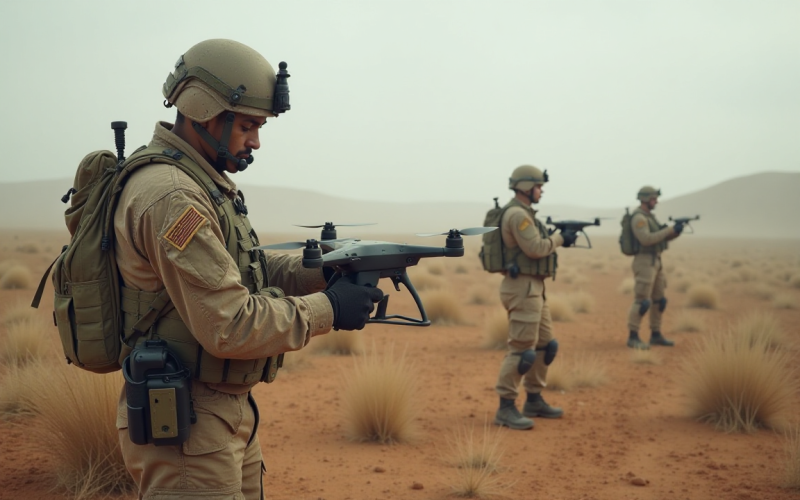After three and a half years of total war, Ukraine’s defence tech industry has become the world’s most active battlefield laboratory.
It’s producing and deploying defence technologies faster, cheaper, and more creatively than any military in modern history.
With $43 billion secured for its defence industry this year, over one million drones produced in 2024 alone, and exports of battlefield-hardened robotics waiting on a green light, Ukraine is now the startup nation of war.
This isn’t about holding the line anymore. What’s happening in Ukraine is something much bigger and more unsettling: the entire architecture of how nations fight wars is being rewritten in real time.
From NATO procurement to battlefield doctrine, from drone warfare to electronic combat, the next decade of military strategy will be shaped in the garages, trenches, and factories of Ukraine.
Can a war-torn nation become the world’s arms factory?
In 2025, Ukraine formally declared its intent to become self-sufficient in arms manufacturing.
No longer content to rely on dwindling foreign stockpiles, the Zelenskiy administration secured $43 billion in domestic and allied funding to build out Ukraine’s defence industrial base. That’s more than many NATO countries spend annually on total defence.
This year alone, $43 billion has been allocated to support Ukraine’s defense industry. Next year, we call on each ally to allocate 0.25% of their GDP for this. Because supporting Ukraine’s defense means supporting Europe’s security.
The strategy is twofold. First, the “Build with Ukraine” initiative represents a push to establish joint manufacturing lines with European partners using Ukrainian IP, drone designs, and war-tested innovations.
Second, there’s a call for 0.25% of allies’ GDP to be earmarked for co-developing weapons systems with Ukraine.
This is an effort from the country to end its aid dependency on allies. Ukraine wants to be more than NATO’s buffer; it wants to be its arsenal.
How are $400 weapons defeating million-dollar military systems?
The tip of Ukraine’s spear is a vast, fast-evolving, and brutally effective drone ecosystem.
From small garage-built FPVs to long-range strike aircraft and naval kamikaze boats, drones now account for up to 70% of Russian equipment losses, according to a report by the Royal United Services Institute.
The developments are remarkable in their scope and effectiveness. FPV drones (first-person view) now fly day and night in any weather, guided by operators wearing goggles.
Many cost just $400 and destroy vehicles worth hundreds of thousands.
Deep strike drones have hit Russian oil depots, bomber airfields in Siberia, and strategic factories, demonstrating reach across the full Russian interior.
Naval drones, controlled via Starlink, have kept the Russian fleet pinned, destroyed fighter jets, and now carry missiles. Meanwhile, recon and support drones deliver ammo, medevac wounded, and provide real-time targeting for artillery strikes.
Production is scaling exponentially. Ukraine plans to build 2.5 million drones in 2025.
Meanwhile, Russia is aiming for 1.4 million. The drone war is now an industrial arms race in the air, fought meter-by-meter and update-by-update.
Is the future of combat already here?
As drones multiply, so do countermeasures. Both Ukraine and Russia are locked in a cat-and-mouse game of jamming, spoofing, and AI adaptation.
Ukraine’s responses demonstrate the cutting edge of defence innovation. Frequency-hopping drones resist jamming. AI-guided systems can operate the final 100 meters of flight autonomously, using SLAM (Simultaneous Localization and Mapping).
Fiber-optic drones with unjammable tethers enable stealth ambushes.
The front line is not physical anymore. It’s digital, electromagnetic, and algorithmic. Electronic dominance is now as important as air superiority.
What happens when defence innovation runs like Silicon Valley?
This isn’t a Soviet-style military buildup. Ukraine’s defence tech economy looks more like Silicon Valley, characterized by modular development, bottom-up innovation, and ruthless iteration.
Companies like TenCore grew from 5 to 175 employees in one year. The company builds TerMIT, a robot that can deliver supplies, lay mines, or carry wounded soldiers under fire.
It costs just $20,000, which is far less than the cost of losing a human life in combat, and is already being used by more than 20 units across the front.
Skyfall produces Vampire and Shrike drones. These are low-cost, high-impact systems that have destroyed Russian tanks, fighters, and infrastructure.
The company not only builds drones but also trains operators, services devices at the front, and runs 24/7 tech support for soldiers in the field.
Falcons specializes in electronic warfare tools. Their devices can detect Russian jammers, radars, and drone operators from up to 30 km away, giving Ukraine the upper hand in the invisible war for electromagnetic control.
Himera developed a jam-resistant, secure battlefield radio in just a few months. Already 6,000 units are deployed, and the company is producing 1,000 more every month.
The radio uses a stealth mesh network and is now being upgraded through a new partnership with a Canadian firm using quantum-secure encryption.
Swarmer is building a new generation of AI-powered drone coordination software. Their systems allow large numbers of cheap drones to fly in automated swarms.
They map targets, share data, and overwhelm enemy defences faster than any single drone could.
These startups are moving faster than traditional defence firms, building what soldiers actually need and getting it into battle within days.
If allowed to export, it could flood the global market with cheap, combat-tested solutions that outperform traditional systems at a fraction of the price.
Will Ukraine be allowed to export its war economy?
Despite world-leading capabilities, Ukraine’s defence firms remain shackled by an export ban.
Government fears that weapons might leak into Russian hands or anger allies are delaying what could be a wartime economic miracle.
The numbers tell a compelling story. Ukraine can produce $36 billion worth of arms annually.
Its procurement budget is just $12 billion. Hundreds of NATO billions are being allocated for rearmament, but Ukraine can’t tap into it.
If the export ban is lifted, Ukrainian firms could fill European rearmament gaps faster and cheaper than any Western contractor.
Defence innovation would no longer depend on foreign grants or viral drone footage.
Ukraine would transform from aid recipient to net contributor to global security. But without capital, these startups risk collapsing just as they reach industrial maturity.
A dangerous future and a model for it
The implications of Ukraine’s transformation are serious, systemic, and deeply global. The line between civilian tech and military power has been erased.
Warfare is now defined by iteration speed, not just weapon yield. Ukraine’s success proves that wartime innovation can outpace industrial scale, but only if capital and trust follow.
Meanwhile, Russia is not standing still. It’s scaling production, adapting tactics, and pouring resources into drone development. This is not a war that will be won by endurance alone. It will be won by who builds faster, adapts faster, and deploys smarter.
The post How Ukraine’s defence tech industry is rewriting the rules of modern warfare appeared first on Invezz


